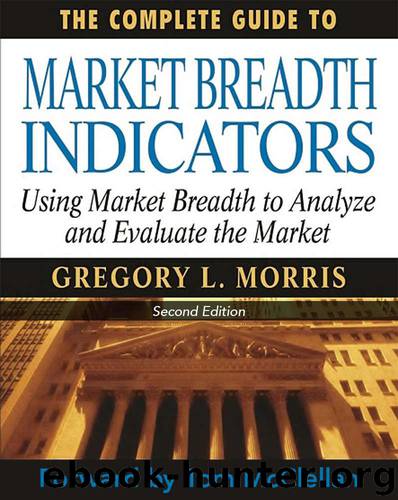The Complete Guide to Market Breadth Indicators: How to Analyze and Evaluate Market Direction and Strength by Morris Gregory

Author:Morris, Gregory [Morris, Gregory]
Language: eng
Format: epub
Publisher: Gregory L. Morris
Published: 2015-11-20T22:00:00+00:00
Chart 1. The First Showing of Advances/Total Issues Traded.
Note: I (Greg) broke the original graphic into a top section and bottom section so I could enlarge them.
Chart 2 in Gartley’s article shows the 7-day moving average of both advances and declines compared to total issues traded between June, 1932, and April 1937. Chart 2 is not shown here because its reproduction is not as clear as that of Chart 1.
IV. Conclusion
Harold M. Gartley originated the Advances/Total Issues Traded as well as the Declines/Total Issues Traded indicators. John Schulz and Harry Shultz popularized AT but cannot be credited with its invention. Morris’ inquiry is answered. Harold M. Gartley originated Advances/Total Issues Traded as Harry Shultz and John Schulz used it fifty years ago. And finally, to borrow liberally from Shakespeare’s Romeo and Juliet:
“What’s in a name? That which is called Schultz AT
By its proper name Gartley AT would be as true.”
Thanks George.
Back with Greg - In the early 1990s, Norm North and I had created a simple Point and Figure charting software that downloaded daily data from Warner Computer. I sent a number of copies out to my short list of folks I knew used Point and Figure, one was John W. Schulz; the same John Schulz mentioned by George and also a founding member of the MTA (Market Technicians Association. John Schulz called me one day to thank me and asked if I would help him get the software going as he claimed he was completely not at home with a computer. Over the next few months we spoke a couple of times a week, usually in the evening and eventually I had him set up to download data every evening, chart it with the box size and reversal period he wanted, and then print it. He was a gentleman 100% of the time. We talked about the markets often – he had a fascinating understanding of the markets. One day I received a large package and in it was his book, “The Intelligent Chartist,” along with many hand-drawn point and figure charts. He asked me if I would like to be on his fax list. I said yes and for a couple of years until he died I received hundreds of hand-drawn charts. Not once did I ask him why he did not use my software.
Formula: (A / TI)
References:
1984 CompuTrac software manual.
Advance Decline Divergence Oscillator
Author/Creator: Arthur Merrill
Data components required: Advances (A), Declines (D), Unchanged (U) Market Index (MKT).
Description: This was Arthur Merrill’s Disparity Index; an attempt to see how a breadth indicator performed relative to a market index. He stated that he did not like the subjectivity of visually looking at a chart of each one. Here is what he said: “The comparison isn’t easy, since the market average is in dollars, and the advance decline line is an accumulation which could start anywhere.” He made the comparison into an oscillator. Rather than subtracting one index from the other, he calculated a simple least squares regression line. The calculation
Download
This site does not store any files on its server. We only index and link to content provided by other sites. Please contact the content providers to delete copyright contents if any and email us, we'll remove relevant links or contents immediately.
| Analysis & Strategy | Bonds |
| Commodities | Derivatives |
| Futures | Introduction |
| Mutual Funds | Online Trading |
| Options | Portfolio Management |
| Real Estate | Stocks |
Rich Dad Poor Dad by Robert T. Kiyosaki(6413)
Pioneering Portfolio Management by David F. Swensen(6229)
How To Win Friends and Influence People by Dale Carnegie(4445)
The Money Culture by Michael Lewis(4081)
The Dhandho Investor by Mohnish Pabrai(3704)
The Wisdom of Finance by Mihir Desai(3657)
Liar's Poker by Michael Lewis(3371)
Fooled by Randomness: The Hidden Role of Chance in Life and in the Markets by Nassim Nicholas Taleb(3046)
The ONE Thing by Gary Keller(3009)
The Intelligent Investor by Benjamin Graham Jason Zweig(2995)
Mastering Bitcoin: Programming the Open Blockchain by Andreas M. Antonopoulos(2981)
Rich Dad Poor Dad: What The Rich Teach Their Kids About Money - That The Poor And Middle Class Do Not! by Robert T. Kiyosaki(2909)
How to Day Trade for a Living: Tools, Tactics, Money Management, Discipline and Trading Psychology by Andrew Aziz(2909)
Investing For Dummies by Eric Tyson(2894)
How to Win Friends and Influence People by Dale Carnegie(2863)
Market Wizards by Jack D. Schwager(2644)
The Psychology of Money by Morgan Housel(2619)
Zero Hour by Harry S. Dent Jr. & Andrew Pancholi(2614)
How to Pay Zero Taxes, 2018 by Jeff A. Schnepper(2602)
